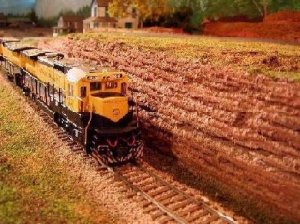Bill, The idea of the ceiling tile is a good one, I don't mean to badmouth it, it just still needs a little effort to produce a nice result. Most of the strata we are looking for is there, we just need to blend the layers. Now, having said all this, I haven't used them! I used homasote scrap, which had no strata like the broken ceiling tile has. So I had to create all the strata, not just touch it up. Still, same idea, if you can detect seperate layers of the homasote, you haven't finished carving! It may be possible with judicious stacking of the tiles to have a nearly verticle rock face, or if you use plaster or some similar material to not have to carve, but I'd certainly rather take a knife to it rather than use plaster. This is probably just preferance, having used almost nothing but plaster for all the early years of my scenery efforts. So far I haven't used any on my current layout, tho I've used some spackle. I'm starting to ramble so I'll stop now.


